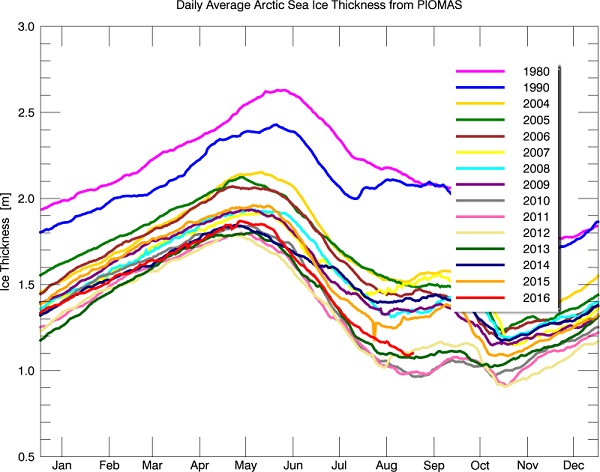1. Arctic sea ice volume collapse
The collapse of the Arctic sea ice volume has been even more dramatic than the extent, as shown in this graph:

It’s down from 16,855 cubic kilometres in 1979 to 4,401 in 2016, that’s an ice loss of about 74%.
There’s more at Neven’s Arctic Sea Ice Blog.
Here’s Neven’s graph of thickness:

At a bit over a metre thick on average much of it could disappear quite quickly.
2. SA storms
The Climate Council has a a factsheet on the SA blackouts. A few comments:
- Like many online documents it doesn’t have a date. This is annoying when it makes reference to current happenings.
- It’s accurate as far as it goes. The main emphasis is that the blackout wasn’t caused by renewable energy, and while unusual in SA there have been plenty of significant blackouts in the eastern states in recent years.
- It also emphasises the role of climate change and the need to reduce emissions.
- It mentions a 228% increase in enquiries about battery storage with their locations directly correlating to more severely storm affected areas. That’s from the managing director of Natural Solar.
3. Great Barrier Reef in trouble
Outside Magazine published an obituary for the Great Barrier Reef on 11 October Obituary: Great Barrier Reef (25 Million BC-2016). This was picked up by some news outlets, with the information that the death had been confirmed by scientists, for example in The Sun: NATURAL DISASTER The Great Barrier Reef ‘dies at 25 million years old after succumbing to coral bleaching’, scientists declare.
No scientists are quoted, and if you read down you get this:
- The Great Barrier Reef Marine Park Authority has started the second phase of its survey to assess the impact of 2016’s bleaching.
The research showed that “22 per cent of the coral on the reef died due to the worst mass bleaching event on record.”
85 per cent of the mortality occurred in a 600km stretch of reef between the tip of Cape York and just north of Lizard Island.
In the very next paragraph they are at it again with “The death of the Great Barrier Reef…”
Think Progress in the US picked up on the story, saying the GBR is not dead, but is very, very, sick. Their main source of information was a video from The Climate Council, which I haven’t viewed.
I did, however, see the ABC Catalyst program on the GBR, which was excellent.
Reefs do exist in much warmer waters but the GBR species can’t evolve in the time-space that the warming is happening. Scientists are experimenting with ‘super corals’ that could adapt, but it’s a problem of scale:
- NARRATION
But if super corals can be created, what to do with them? While small areas could be restored, Terry Hughes cautions it’s a problem of scale.
Prof Terry Hughes
No-one has ever successfully restored a reef, even at the scale of a kilometre, never mind 800km. So prevention is better than cure. The bleaching in the northern part of the Great Barrier Reef this time round is so severe that we’re losing the toughest corals, the 50-year-old, the 100-year-old corals and it takes that length of time for those corals to be replaced so the northern Great Barrier Reef has changed forever.
$6 billion and 70,000 jobs, and part of our national identity.
4. Clinton on climate change
Here’s four places to look:
- Scientific American – Hillary Clinton’s Plan to Combat Climate Change
- New York Times – Hillary Clinton’s Ambitious Climate Change Plan Avoids Carbon Tax
- Laurence Kotlikoff at Forbes – Debating Trump and Clinton on Climate Change Policy
- Grist – 8 things you need to know about Hillary Clinton and climate change
Three important things to keep in mind.
First, no-one takes Donald Trump seriously. He has called climate change “bullshit” and “a hoax”, and says he will slash funding to the EPA. He’s referred to Clinton’s energy policy as “extreme, reckless anti-energy agenda … to appease radical donors (who) will destroy millions of jobs and force millions more into abject poverty.” But he’s reserved the right to change his mind.
Second, John Podesta, who designed Obama’s climate change policies, is Clinton’s close confidant and campaign chair. Her policies look much like Obama’s, but she’s going to try harder.
Third, Podesta and Clinton are assuming that Congress will be hostile to climate change.
She may get some funds from winding back fossil fuel subsidies, but Congress would have to agree. She wants to help coal communities devastated by the collapsing industry.
Grist points out that she shares some of Obama’s downsides, as seen by environmentalists, in supporting fracking, offshore oil drilling and won’t comment on the Keystone pipeline.
5. Global deal reached to limit use of hydrofluorocarbons
In recent years the use of hydrofluorocarbons (HFCs) has soared as countries like India and China increasingly install air-conditioning.
Countries meeting in Kigali, Rwanda, have now agreed to caps and reduce HFCs – in a gradual process beginning in 2019, with developing countries starting in 2024.
HFCs are a thousand time more potent as a greenhouse gas.
- Environmental groups had hoped the deal could reduce global warming by a half a degree celsius by the end of this century. This agreement gets about 90% of the way there, said Durwood Zaelke, president of the Institute for Governance and Sustainable Development.


Coral reef bleaching and death is a problem in parts of WA too.
Thanks, John. Sad to see!